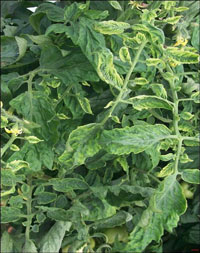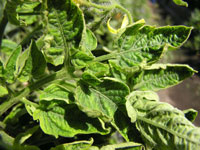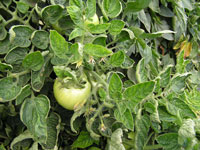Tomato Yellow Leaf Curl Virus Management for Homeowners
Recently there has been a lot of publicity concerning the  latest imported
pest problem of Florida agriculture - tomato yellow leaf curl virus (TYLCV).
This disease probably entered Florida this past spring from the Caribbean
in the form of infected plants, plants hosting infective whiteflies or most directly by wind carried virus-bearing whiteflies. From one or more
sites of infestation, the vector and virus has entered into transplant
production nurseries and subsequently been distributed within Florida to
homeowners by way of several retail department stores. Presently, this
virus has been found in retail outlets in the southeast, southwest and
north central areas of Florida and has been inadvertently shipped out-of-state
as well.
latest imported
pest problem of Florida agriculture - tomato yellow leaf curl virus (TYLCV).
This disease probably entered Florida this past spring from the Caribbean
in the form of infected plants, plants hosting infective whiteflies or most directly by wind carried virus-bearing whiteflies. From one or more
sites of infestation, the vector and virus has entered into transplant
production nurseries and subsequently been distributed within Florida to
homeowners by way of several retail department stores. Presently, this
virus has been found in retail outlets in the southeast, southwest and
north central areas of Florida and has been inadvertently shipped out-of-state
as well.
What is TYLCV?
This is one of more than a dozen plant viruses that can infect tomatoes in both the home garden and commercial production fields in Florida. In contrast to the other viruses, the impact of TYLCV can be quite severe - virtually eliminating fruit production when plants are infected at an early age. The virus is physically spread plant-to-plant by the silverleaf whitefly. These insects can acquire this virus in 15-30 minutes during a feeding period on an infected plant. These infective whiteflies can then retain the virus for 10-12 days and introduce it into any number of healthy tomatoes during feeding periods. After this 10-12 day period, these infective whiteflies must reacquire this virus by feeding upon an infected plant again. In contrast to other common tomato viruses in Florida, TYLCV does not survive in soil, on tomato stakes, wire or string and cannot be moved mechanically through such common activities as tying plants, suckering plants or even harvesting fruit. This virus does survive in other crops and weed species but the important host range for this virus in Florida is as yet unknown.
How do you diagnose TYLCV?
TYLCV caused a range of symptoms that include marginal leaf yellowing, upward or downward leaf cupping, reduction in leaf size, flower and/or fruit drop, and plant stunting. Most homeowners, however, fail to realize that not all the above symptoms exist at the same time and more importantly, that these individual symptoms are not specific to TYLCV or even viral diseases in general.
When a group of plants have been purchased from a retail outlet and planted in the garden, TYLCV may exist in one to all the plants. The earliest symptoms to observe will be marginal leaf yellowing of the newest leaf or leaves with mild cupping. Due to plant age, symptoms like plant stunting and flower and fruit abortion will not be evident as yet. When tomato transplants are purchased from more than one supplier, early symptoms of TYLCV can be perceived more easily by the contrast among infected and non-infected tomatoes in the garden or between nearby garden plots. As infected plants age, the more dramatic symptoms of leaf cupping, reduction in leaf size, flower drop and plant stunting can be observed - especially when healthy tomatoes in the same area for comparison.
Remember that the visual diagnosis of TYLCV is more accurate when two or more symptoms can be confirmed from the same plant. Defining TYLCV based upon just marginal leaf yellowing or slight leaf cupping can lead to errors. Single symptoms have other possible causes when they develop in tomato as follows:
 Leaf yellowing -- marginal yellowing of older leaves can be due to
magnesium deficiency while general older leaflet yellowing may reflect
nitrogen deficiency. New leaves with marginal yellowing can be produced
by iron deficiency where plants are growing in highly alkaline sites
as well as the luteovirus, tomato yellow.
Leaf yellowing -- marginal yellowing of older leaves can be due to
magnesium deficiency while general older leaflet yellowing may reflect
nitrogen deficiency. New leaves with marginal yellowing can be produced
by iron deficiency where plants are growing in highly alkaline sites
as well as the luteovirus, tomato yellow. - Leaf curl (upward) -- progressive lower leaf curl is most likely
due to physiological leaf curl that results from severe interruption
in water supply within the plant - particularly at fruit bearing
age. Such factors as drought or severe pruning can trigger this
disorder. Leaf curl expressed first at the
 top of the plant (like
TYLCV does) can also be caused by excessive aphid feeding on the
lower leaf surfaces or infection by such viruses as cucumber mosaic,
tobacco mosaic virus and pseudo curly top.
top of the plant (like
TYLCV does) can also be caused by excessive aphid feeding on the
lower leaf surfaces or infection by such viruses as cucumber mosaic,
tobacco mosaic virus and pseudo curly top. - Reduced leaflet size -- many individual viruses like tobacco mosaic, cucumber mosaic and pseudo curly top as well as virus combinations can produce this symptom.
- Stunting -- pseudo curly top geminivirus and combinations of viruses can reduce plant vigor causing a stunted plant.
- Flower
drop -- loss
of the first
flower cluster
often occurs
as a result
of adverse
environmental conditions
or slight
imbalances
in soil moisture
levels. Prolonged
flower abortion
is more indicative
of TYLCV.

How to Manage TYLCV!
Management of TYLCV is a multi-step strategy. Plants suspected of TYLCV infection should be rogued from the garden and destroyed in the following manner:
- symptomatic plants should be carefully covered by a clear or black plastic bag and tied at the stem at soil line. Cut off the plant below the bag and allow bag with plant and whiteflies to desiccate to death on the soil surface for 1-2 days prior to placing the plant in the trash. Do not cut the plant off or pull it out of the garden and toss it on the compost! The goal is to remove the plant reservoir of virus from the garden and to trap the existing virus-bearing whiteflies so they do not disperse onto other tomatoes.
- If symptomatic plants have no obvious whiteflies on the lower leaf surface, these plants can be cut from the garden and BURIED in the compost.
- Although the silverlef whitefly feeds on more than 500 plants, some of its more favorite vegetable hosts other than tomatoes include the squash and cucumber family of plants, okra, beans, peanuts & eggplant. Favorite landscape plants include hibiscus, poinsettia, Gerbera daisy and many bedding plants.
- Inspect plants for whitefly infestations two times per week. If whiteflies are beginning to appear, spray with azadirachtin (Neem), pyrethrin or insecticidal soap. For more effective control, it is recommended that at least two of the above insecticides be rotated at each spraying. Follow label directions closely for dosage rates, spray intervals and precautions. Spray the undersides of the leaves thoroughly.
Due to the confusion among TYLCV symptoms and those caused by other viruses or environmental factors, some homeowners may seek confirmation. The Florida Extension Plant Disease Clinic is presently implementing a research method for the verification of TYLCV. This fee-based service should be available in August 1997. Further information on this service is available at your county extension office.


